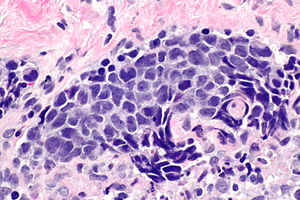Difference between revisions of "Small cell carcinoma"
Jump to navigation
Jump to search

| Line 57: | Line 57: | ||
Image: Small cell carcinoma in lymph node -- very high mag.jpg | Small cell carcinoma in a lymph node - very high mag. (WC) | Image: Small cell carcinoma in lymph node -- very high mag.jpg | Small cell carcinoma in a lymph node - very high mag. (WC) | ||
</gallery> | </gallery> | ||
==IHC== | |||
*[[Neuroendocrine markers]] +ve - confirm the diagnosis. | |||
*Not particularity useful for determination of the primary site.<ref name=pmid17270664>{{Cite journal | last1 = Lobins | first1 = R. | last2 = Floyd | first2 = J. | title = Small cell carcinoma of unknown primary. | journal = Semin Oncol | volume = 34 | issue = 1 | pages = 39-42 | month = Feb | year = 2007 | doi = 10.1053/j.seminoncol.2006.10.027 | PMID = 17270664 }}</ref> | |||
==See also== | ==See also== | ||
Revision as of 17:24, 29 January 2016

Micrograph showing a small cell carcinoma.
Small cell carcinoma is a type of carcinoma. It is mostly commonly from the lung; 95% of cases are from the lung.[1]
It may be abbreviated SCC, leading to confusion with squamous cell carcinoma.
Overview
Grouping
May be grouped as:[1]
- Pulmonary.
- Gastrointestinal.
- Genitourinary.
- Small cell carcinoma of the prostate gland - most common small cell carcinoma outside of the lung.[2]
- Small cell carcinoma of the urinary bladder.
- Ovarian small cell carcinoma of the hypercalcemic type.
- Head & neck.
- Breast.
- Other.
Sites other than lung
General
Classic tumour with paraneoplastic syndromes - may be associated with:[6]
- Syndrome of inappropriate antidiuretic hormone secretion (SIADH).
- Clinical: hyponatremia.
- Paraneoplastic cerebellar degeneration.
- Lambert-Eaton myasthenic syndrome.
Microscopic
Features:
- Small cells -- typically 15-20 micrometers ~ 2x the size of RBC.
- Scant cytoplasm.
- Stippled chromatin +/- smudging of the chromatin.
- +/-Nuclear moulding.
DDx:
- Endometrial stromal condensation.
- Large cell lymphomas, e.g. DLBCL, ALCL.
- Chloroma.
- Rhabdomyosarcoma - usu. CD56 positive, may be keratin positive and positive for other neuroendocrine markers.[7]
- Other small round cell tumours.
Images
Small cell carcinoma in a lymph node
IHC
- Neuroendocrine markers +ve - confirm the diagnosis.
- Not particularity useful for determination of the primary site.[8]
See also
- Lung tumours.
- Azzopardi phenomenon.
- Chloroma (AKA granulocytic sarcoma, myeloid sarcoma).
- Neuroendocrine tumours.
References
- ↑ 1.0 1.1 Grossman, RA.; Pedroso, FE.; Byrne, MM.; Koniaris, LG.; Misra, S. (May 2011). "Does surgery or radiation therapy impact survival for patients with extrapulmonary small cell cancers?". J Surg Oncol. doi:10.1002/jso.21976. PMID 21618245.
- ↑ Furtado, P.; Lima, MV.; Nogueira, C.; Franco, M.; Tavora, F. (2011). "Review of small cell carcinomas of the prostate.". Prostate Cancer 2011: 543272. doi:10.1155/2011/543272. PMID 22110988.
- ↑ Cesaretti, M.; Guarnieri, A.; Gaggelli, I.; Tirone, A.; Francioli, N.; Carli, AF.. "Small cell carcinoma of the breast. Report of a case.". Ann Ital Chir 82 (1): 61-4. PMID 21657157.
- ↑ Beach, DF.; Klump, WJ.; Haddad, G.; Reid, LM.; Schwarting, R.; Hageboutros, A. (Jun 2011). "Extrapulmonary small cell: a novel case of small cell carcinoma of the thyroid gland.". Med Oncol. doi:10.1007/s12032-011-9996-7. PMID 21644012.
- ↑ Morikawa, H.; Nakayama, Y.; Maeda, T.; Nadatani, Y.; Kobayashi, S.; Iwai, S.; Enomoto, M.; Tamori, A. et al. (Dec 2008). "A case of primary small cell carcinoma of the liver that was treated with chemotherapy.". Hepatol Int 2 (4): 500-4. doi:10.1007/s12072-008-9090-1. PMID 19669327.
- ↑ Sher, T.; Dy, GK.; Adjei, AA. (Mar 2008). "Small cell lung cancer.". Mayo Clin Proc 83 (3): 355-67. PMID 18316005.
- ↑ Bahrami, A.; Gown, AM.; Baird, GS.; Hicks, MJ.; Folpe, AL. (Jul 2008). "Aberrant expression of epithelial and neuroendocrine markers in alveolar rhabdomyosarcoma: a potentially serious diagnostic pitfall.". Mod Pathol 21 (7): 795-806. doi:10.1038/modpathol.2008.86. PMID 18487991.
- ↑ Lobins, R.; Floyd, J. (Feb 2007). "Small cell carcinoma of unknown primary.". Semin Oncol 34 (1): 39-42. doi:10.1053/j.seminoncol.2006.10.027. PMID 17270664.






